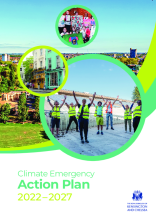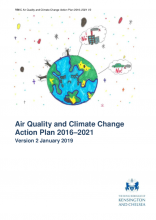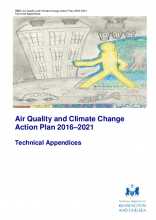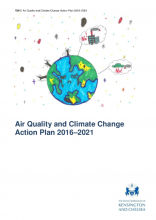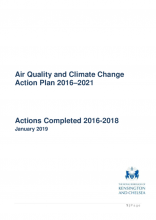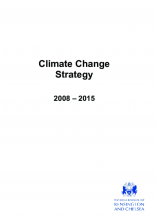Climate Change Strategies and Action Plans
On this page
Climate Change Strategies and Action Plans
Kensington and Chelsea Council declared climate emergency in October 2019 and adopted 2 ambitious carbon neutral targets:
- For the Council to be a net zero carbon organisation by 2030.
The Council is committed to leading by example: by reducing emissions from Council operations and buildings, by embedding the reduction of carbon emissions in all relevant decision-making and operations (where the Council has direct influence), and by ensuring that its services and operations are adaptable and resilient to the impacts of climate change. - For the borough to become carbon neutral target by 2040, 10 years ahead of the Governmentʼs targets.
The Council’s climate emergency motion was approved and passed unanimously at the January 2020 Full Council meeting.
This new Climate Emergency Action Plan sets out the Council’s response to the climate emergency, and the collective action required to deliver the carbon neutral targets. Our priorities are to lead by example: to reduce emissions from our own and contractors’ operations, to empower residents, to work in partnership with others and to influence change across the borough.
This action plan concentrates on mitigation and adaptation, through actions to reduce emissions and awareness-raising initiatives(such as carbon literacy training for Council staff , climate change assemblies in schools, paid training for young people, green skills certification/training opportunities for residents, behaviour change campaigns to encourage people to reduce consumption emissions.
The action plan is guided by the following objectives. The Council wants to:
Reduce emissions at pace
Target the main sources of emissions, such as buildings (commercial and residential), transport and waste; work with key stakeholders across the borough to address and reduce emissions.
Reduce exposure and increase resilience
Protect the natural environment while increasing the borough’s resilience; manage climate change risks from extreme weather events through sustainable adaptation measures, focusing on vulnerable people.
Show leadership and influence change
Lead by example and embed climate change in all decision-making where the Council has direct control (operations, buildings, procurement, planning policies, etc.); improve public awareness and understanding of the impacts of climate change; lobby the Mayor of London, central government and external bodies for more stringent standards and tighter regulations, policy changes, funding and incentives for vulnerable residents and small businesses.
Put people first and tackle inequalities
Prioritise interventions and climate change actions that reduce health inequalities, deprivation, social injustice and residents’ exposure to climate change impacts (such as flooding, heatwaves and cold homes); give the vulnerable and disadvantaged communities a better quality of life.
Create strong partnership and a Climate Coalition/Steering Group
Support, empower and work with people who live, work and study in the borough to take collective action; build partnerships with residents’ associations, key organisations, community groups and local businesses across the borough to ensure they also respond to the climate emergency and identify new climate initiatives.
Monitor and report carbon emissions and the co-benefits of climate change
Report (on an annual basis) the carbon savings achieved through the Carbon Performance Report, including in-house and borough-wide emissions; communicate to residents the co-benefits of climate actions (such as improvements to health and wellbeing, improved quality of food, improved equity and social cohesion, improved air quality, reduced fuel poverty rates, economic benefits, new green jobs, green skills created, etc.)
The action plan is a live document that will be updated every year. The actions have been grouped into 6 categories:
1. Buildings and Energy
2. Sustainable Transport and Travel
3. Waste and Circular Economy
4. Leading by example
5. People and Partnerships
6. Places and Greener Borough
Air Quality and Climate Change Action Plan 2016 – 2021
After the Climate Change Strategy expired in 2015, the Council has decided to tackle the twin challenges of climate change and poor air quality together. Emissions of these air pollutants and greenhouses gases come from common sources such as vehicles, buildings, power generation and industry.
The Council is tackling the twin challenges of climate change and poor air quality together and has put in place a combined 2016-2021 Air Quality and Climate Change Action Plan (AQCCAP). Visit the Air Quality and Climate Change Action Plan 2016 - 2021 page.
The first step to deliver the net zero carbon targets and deliver the Council’s Vision Carbon Zero is to develop a bold and radical action plan which will be published in 2020. This will be included in a new updated Air Quality and Climate Change Action Plan.
The Air Quality and Climate Change Policy can be found in section 1 of the AQCCAP (page 4).
The Plan is a combination of measures aimed at reducing emissions of greenhouse gases and urban air pollutants. The key aspects of the Plan are:
- our aims and objectives for the period 2016–2021 to tackle poor air quality and climate change
- a list of actions to meet these aims and objectives which will be regularly updated, with completed actions being replaced by new ones throughout the Plan’s lifetime.
The Plan is supported by a series of appendices giving technical information.
Action Plan progress
To address poor air quality, the whole of the Royal Borough has been designated as an Air Quality Management Area since 2002. Consequently, the Council is obliged to publish and implement a plan of action to address the unacceptable levels of two key pollutants: nitrogen dioxide and fine particles. For more information see the Air Quality page.
The Council is also very concerned about the impacts of climate change, and in 2008 it produced its first seven-year Climate Change Strategy. This strategy demonstrated the Council’s leadership in reducing carbon emissions from its own operations and its ambitions to mitigate and adapt to climate change in the Royal Borough.
Climate change and air pollution are intimately connected, and therefore with the latest combined 2016-2021 Air Quality and Climate Change Action Plan we are joining up our approach to the same emission sources and developing holistic ways to take action to reduce emissions and their impacts. Both air pollution and climatic changes threaten our health and well-being.
The Council adopted in October 2019 the net zero carbon targets for the Council’s operations by 2030 and for the borough to be carbon neutral by 2040 and announced that is aligning with the other London boroughs in declaring climate emergency.
In January 2007, the Council signed the Nottingham Declaration on Climate Change. We adopted a Climate Change Strategy in 2008 and set up Climate Change Programme to reduce the Council’s carbon emissions.
The Council had an initial target to reduce carbon emissions 20 per cent by March 2014 and 40 per cent by March 2020 from a 2007/08 baseline level. In 2018/2019 the Council exceeded its initial 40% carbon reduction target and achieved a 50% carbon reduction compared to 2007/2008 (excluding the Housing stock/portfolio). Even though our emissions are just 1.8% of the borough’s total, the new net zero carbon target is going to take a total shift in how we operate.
For more information on the 40% target and the progress achieved, please visit the Carbon Performance page.
Last updated: 29 January 2024

